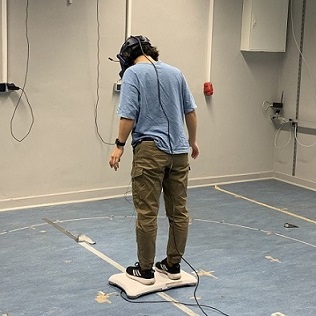
Full text
Share
|
AbstractPostural control strategies for upright stance adapt when balance is threatened. We investigate behavioral indicators for control strategy change in Virtual Reality (VR). Previous VR research has shown increased postural sway during virtual height exposure, but most studies focus on outdoor-like environments with extensive visual cues that may influence balance. In contrast to these outdoor studies, our indoor VR results indicate that virtual height exposure increases the mean power frequency (MPF) of sway while reducing anterior-posterior (AP) sway range. We also find an anterior shift of the Center of Pressure (CoP) when there are vertical drops both on the front and back. These findings suggest a strong context-dependence of the strategy humans employ to counteract perceived threat and heightened neuromotor control for balance stabilization. |